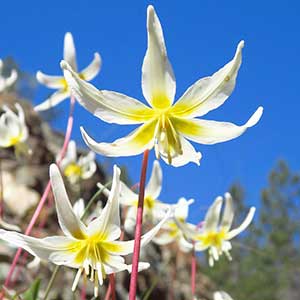Erythronium citrinum
Erythronium rostratum
citrus fawn lily, cream fawn lily, lemon color fawn lily, lemon fawn lily, pale fawn-lily
beak trout-lily, yellow fawnlily, yellow troutlily
slender, 40–50 mm, sometimes producing sessile offsets.
ovoid, 10–20 mm;
stolons 1–3, common, mostly on 1-leaved, nonflowering plants.
9–15 cm;
blade mottled with irregular streaks of brown or white, lanceolate to narrowly ovate, margins ± wavy.
5–18 cm;
blade green, irregularly mottled, elliptic-lanceolate to ovate or elliptic, ± flat, not glaucous, margins entire.
12–35 cm.
3–10 cm.
1–3-flowered.
1-flowered.
tepals ± white, often pinkish, usually pale yellow at base, lanceolate to narrowly elliptic, 25–45 mm, inner with or without small auricles at base;
stamens 11–17 mm;
filaments linear, white or pinkish, slender, less than 0.8 mm wide;
anthers white, cream, pink, reddish, or brownish red;
style straight, white or pink, 6–10 mm;
stigma unlobed or with lobes shorter than 1 mm.
held erect at anthesis;
tepals yellow, tinged red-purple or orange abaxially, mostly spreading at anthesis, lanceolate, 20–34 mm, inner with conspicuous, well-developed auricles almost encircling opposing filaments;
stamens 13–17 mm;
filaments yellow, lanceolate;
anthers yellow;
pollen yellow;
style persistent, greenish yellow, swollen distally into stigma, tapering gradually proximally to ovary, forming beak on capsule, 8–11 mm;
stigma lobes erect, short, 1 mm.
obovoid, 2–5 cm.
held erect at maturity on upward-curving peduncle, ellipsoid to ellipsoid-obovoid, 15–25 mm (excluding beak), apex long-beaked.
= 24.
= 24.
Erythronium citrinum
Erythronium rostratum
Plants lacking auricles on inner tepals are sometimes segregated as Erythronium howellii, Howell’s fawn-lily, but they do not appear to differ from typical E. citrinum in any other characters. Erythronium citrinum intergrades with E. californicum and E. hendersonii, occasional populations or individuals displaying intermediate or recombined characteristics. Such plants from the upper Scott River drainage in Trinity County, California, which may be the result of introgression with E. hendersonii, have been recognized as variety roderickii.
(Discussion copyrighted by Flora of North America; reprinted with permission.)
Erythronium rostratum is found mostly on either side of the Mississippi River embayment, but rarely within it. It often forms extensive colonies where nonflowering, 1-leaved plants far outnumber flowering ones. This is the only species of Erythronium with erect rather than nodding flowers. Some plants at the western limits of the range are triploids (B. L. Carr 1986).
(Discussion copyrighted by Flora of North America; reprinted with permission.)
